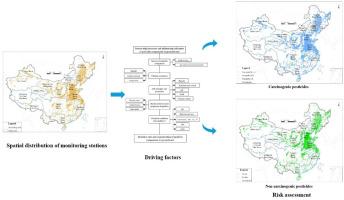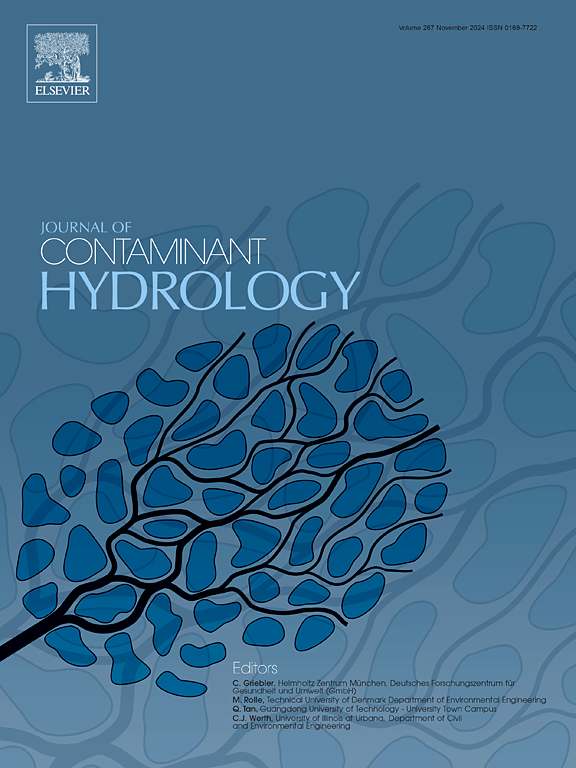A nationwide study on the occurrence, driving factors and exposure assessment of typical pesticides in groundwater in China
IF 4.4
3区 环境科学与生态学
Q2 ENVIRONMENTAL SCIENCES
引用次数: 0
Abstract
Pesticides are widely used in agricultural production, and their residues migrate to aquifers, threatening groundwater safety. This study investigated the occurrence and distribution characteristics of 18 typical pesticide components in different environmental media in China. Meanwhile, the driving factors of the migration and transformation of pesticide components in groundwater were identified. The results show that among 20,010 groundwater monitoring sites, the proportions of the average concentrations of the 18 pesticide components at not detected (ND), ND-1 μg/L, 0.1–1 μg/L, and greater than 1 μg/L are 40.42 %, 25.85 %, 26.59 %, and 7.14 %, respectively. Among 15 groundwater resource regions, the proportions of groundwater with average pesticide concentrations greater than 1 μg/L in the Liaohe River Basin, Songhua River Basin, and Huaihe River Basin are 22.92 %, 16.62 %, and 10.92 % respectively. The detected concentration of pesticides in groundwater decreases significantly with increasing monitoring depth. Based on the multi-factor analysis of the source-sink processes of pesticides in groundwater, pesticides tend to accumulate in phreatic aquifers with relatively more rainfall, shorter sunshine duration, higher permeability of the vadose zone, a primarily reducing environment, and TDS less than 1000 mg/L. In some monitoring sites with phreatic aquifers, pesticide components of chlorpyrifos, pentachlorophenol, 1,2,3,4,5,6-hexachlorocyclohexane, lindane, hexachlorobenzene, heptachlor and malathion pose non-carcinogenic and carcinogenic risks to human health.

中国地下水典型农药的发生、影响因素及暴露评价研究
农药在农业生产中广泛使用,农药残留迁移到含水层,威胁地下水安全。研究了18种典型农药成分在中国不同环境介质中的发生和分布特征。同时,确定了地下水中农药成分迁移转化的驱动因素。结果表明,在20010个地下水监测点中,未检出(ND)、ND-1 μg/L、0.1-1 μg/L和大于1 μg/L的18种农药成分平均浓度所占比例分别为40.42%、25.85%、26.59%和7.14%。在15个地下水资源区中,辽河流域、松花河流域和淮河流域农药平均浓度大于1 μg/L的地下水比例分别为22.92%、16.62%和10.92%。随着监测深度的增加,地下水中农药检测浓度显著降低。通过对地下水中农药源库过程的多因素分析,发现降水相对较多、日照时数较短、渗透带渗透性较高、TDS小于1000 mg/L为还原性环境的潜水含水层中农药倾向于积累。在一些有潜水含水层的监测点,毒死蜱、五氯酚、1,2,3,4,5,6-六氯环己烷、林丹、六氯苯、七氯和马拉硫磷等农药成分对人体健康存在非致癌性和致癌性风险。
本文章由计算机程序翻译,如有差异,请以英文原文为准。
求助全文
约1分钟内获得全文
求助全文
来源期刊

Journal of contaminant hydrology
环境科学-地球科学综合
CiteScore
6.80
自引率
2.80%
发文量
129
审稿时长
68 days
期刊介绍:
The Journal of Contaminant Hydrology is an international journal publishing scientific articles pertaining to the contamination of subsurface water resources. Emphasis is placed on investigations of the physical, chemical, and biological processes influencing the behavior and fate of organic and inorganic contaminants in the unsaturated (vadose) and saturated (groundwater) zones, as well as at groundwater-surface water interfaces. The ecological impacts of contaminants transported both from and to aquifers are of interest. Articles on contamination of surface water only, without a link to groundwater, are out of the scope. Broad latitude is allowed in identifying contaminants of interest, and include legacy and emerging pollutants, nutrients, nanoparticles, pathogenic microorganisms (e.g., bacteria, viruses, protozoa), microplastics, and various constituents associated with energy production (e.g., methane, carbon dioxide, hydrogen sulfide).
The journal''s scope embraces a wide range of topics including: experimental investigations of contaminant sorption, diffusion, transformation, volatilization and transport in the surface and subsurface; characterization of soil and aquifer properties only as they influence contaminant behavior; development and testing of mathematical models of contaminant behaviour; innovative techniques for restoration of contaminated sites; development of new tools or techniques for monitoring the extent of soil and groundwater contamination; transformation of contaminants in the hyporheic zone; effects of contaminants traversing the hyporheic zone on surface water and groundwater ecosystems; subsurface carbon sequestration and/or turnover; and migration of fluids associated with energy production into groundwater.
 求助内容:
求助内容: 应助结果提醒方式:
应助结果提醒方式:


